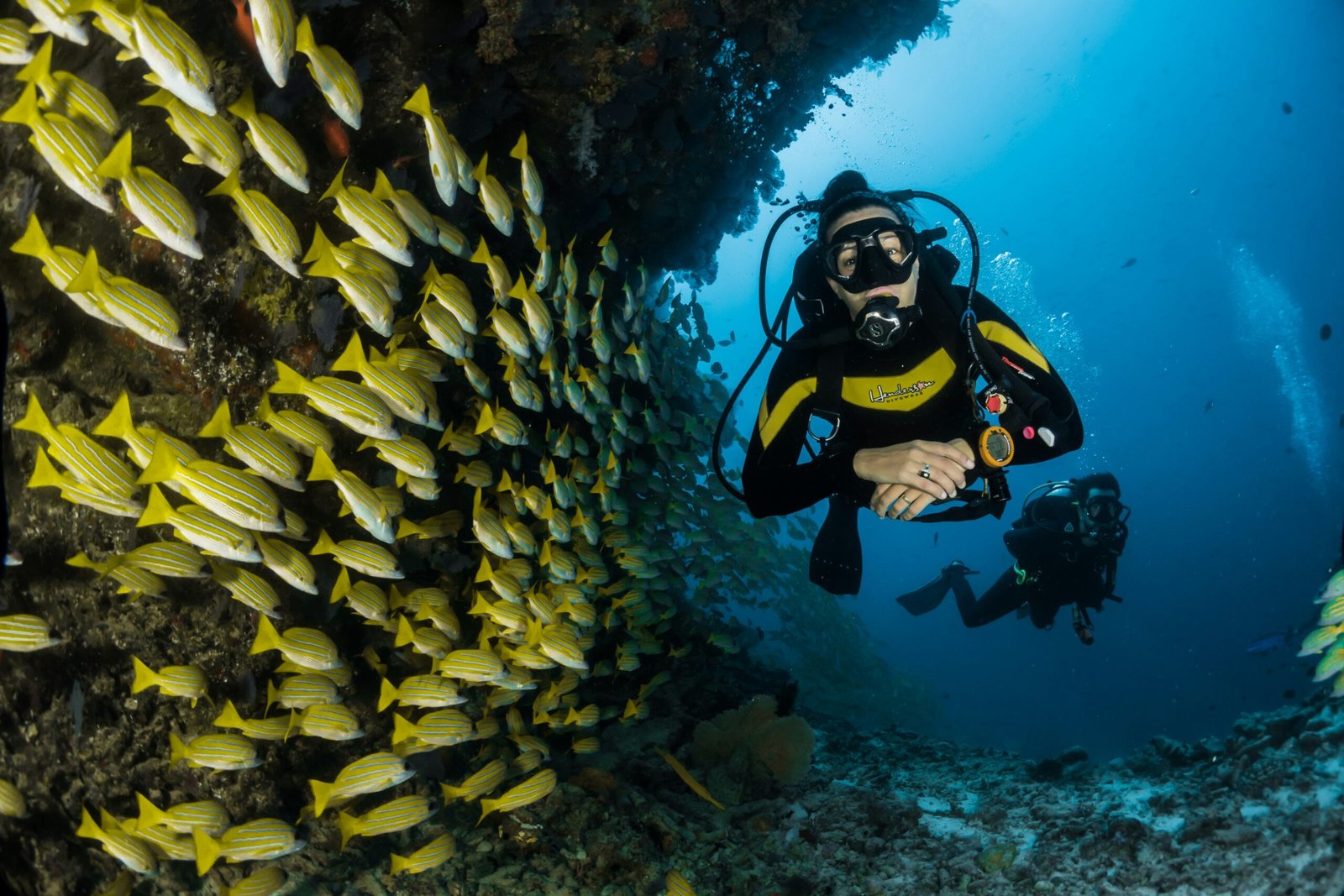Introduction to Thailand Scuba Diving Scene
Thailand Scuba diving has long been celebrated as a premier destination for scuba diving enthusiasts from around the globe. The country boasts an incredibly rich marine biodiversity, making its underwater realm a veritable paradise for divers. With its warm waters and excellent visibility, exploring the depths of Thailand’s oceans offers a truly immersive experience.
One of the key attractions for divers in Thailand is the variety of dive sites available. Whether you are a novice diver or a seasoned professional, Thailand’s underwater landscapes cater to all skill levels. From vibrant coral reefs teeming with colorful marine life to mysterious wrecks and intricate cave systems, there is an adventure waiting for every diver.
The coral reefs, in particular, are a highlight for many. These underwater gardens are home to an array of marine species, including vibrant corals, exotic fish, and other captivating sea creatures. Sites such as Koh Tao and Sail Rock are renowned for their stunning coral formations and the diverse marine life they support. These locations offer a glimpse into the thriving underwater ecosystems that make Thailand a top destination for divers.
For those seeking a bit more adventure, Thailand also offers thrilling wreck dives. The submerged remnants of ships and other structures provide unique habitats for marine life and offer divers an exciting and historical underwater exploration. The caves, on the other hand, present a more challenging yet equally rewarding experience, where divers can navigate through fascinating underwater passages.
Overall, the combination of Thailand’s exceptional marine biodiversity, favorable diving conditions, and diverse range of dive sites makes it a haven for scuba diving enthusiasts. Whether you are exploring the coral reefs, investigating wrecks, or delving into underwater caves, Thailand’s scuba diving scene promises an unforgettable and enriching experience.
Koh Tao, often referred to as the “Diver’s Paradise,” stands out as one of the premier scuba diving destinations in the world. Renowned for its crystal-clear waters and abundant marine life, this small island in the Gulf of Thailand has garnered a reputation as a global hub for diving certifications. Whether you are a novice eager to take your first plunge or an experienced diver looking to explore new underwater terrains, Koh Tao offers an array of opportunities to enhance your diving skills.
One of the most notable aspects of Koh Tao is its plethora of dive schools. With over 50 dive centers scattered across the island, Koh Tao provides ample options for divers of all levels. These schools are renowned for their professional instructors, state-of-the-art equipment, and comprehensive training programs. Many of these institutions are accredited by leading diving organizations such as PADI (Professional Association of Diving Instructors) and SSI (Scuba Schools International), ensuring high standards of safety and education.
In addition to its dive schools, Koh Tao boasts a variety of dive sites that cater to different skill levels and interests. Among the most popular spots is Chumphon Pinnacle, a deep dive site famous for its stunning underwater rock formations and vibrant marine life, including barracudas, giant groupers, and whale sharks. Another noteworthy site is Shark Island, named for its dorsal fin-like shape, which offers divers the chance to encounter blacktip reef sharks, colorful coral gardens, and a diverse array of reef fish.
Moreover, the island’s convenient location means that dive sites are easily accessible by short boat rides, allowing for multiple dives in a single day. The calm and warm waters surrounding Koh Tao provide excellent visibility, making it easier for divers to appreciate the underwater scenery. Whether you’re exploring the intricate coral reefs or swimming alongside majestic sea creatures, Koh Tao promises an unforgettable diving experience.
Diving at Sail Rock: A Must-Visit Spot
Located in the Gulf of Thailand, Sail Rock stands as one of the premier scuba diving spots, drawing enthusiasts from around the globe. The site is renowned for its striking geographical features, most notably the towering submerged pinnacle that emerges dramatically from the seabed. This natural structure extends approximately 15 meters above the surface, offering a unique underwater landscape that captivates divers of all skill levels.
One of the most compelling reasons divers flock to Sail Rock is the abundance and diversity of marine life. The site teems with large schools of fish, including vivid fusiliers and shimmering trevallies. Divers often encounter majestic barracudas patrolling the waters, their sleek bodies cutting through the ocean with effortless grace. For those fortunate enough, the awe-inspiring sight of a whale shark, the gentle giant of the sea, is an unforgettable highlight. These magnificent creatures can be seen gliding through the water, adding an element of wonder to the diving experience.
Sail Rock also offers a unique feature for more advanced divers: the vertical chimney swim-through. This natural underwater passage allows divers to ascend from a depth of around 18 meters to 6 meters, navigating through a narrow vertical tunnel. The experience is both thrilling and visually stunning, as the walls of the chimney are adorned with vibrant corals and sponges, providing a habitat for a myriad of smaller marine species.
The site’s exceptional visibility and relatively mild currents make it accessible for divers ranging from beginners to seasoned experts, ensuring a safe and exhilarating experience for all. Whether it is the sheer biodiversity, the towering pinnacle, or the excitement of the chimney swim-through, Sail Rock remains an essential dive destination when exploring the underwater wonders of Thailand.
Best Time to Dive in Koh Tao and Sail Rock
The optimal diving seasons in Koh Tao and Sail Rock significantly influence the overall diving experience. Understanding the weather patterns, water temperatures, and visibility during different times of the year is crucial for planning a successful diving trip.
In Koh Tao, the peak diving season generally spans from March to September. During these months, divers can expect calm seas, excellent water clarity, and favorable weather conditions. Water temperatures range from 28°C to 30°C, providing a comfortable environment for divers. Visibility is typically at its best, often reaching up to 30 meters, which enhances the underwater experience. The months of April and May are particularly notable for their pristine conditions, making them the most popular times to visit.
Sail Rock, located between Koh Tao and Koh Phangan, also enjoys optimal diving conditions during the same period. The site is renowned for its rich marine life and impressive underwater topography. From March to September, visibility often exceeds 30 meters, and the water temperature remains consistent with Koh Tao, ranging between 28°C and 30°C. These factors contribute to a superior diving experience, allowing divers to fully appreciate the vibrant coral reefs and diverse marine species.
For those interested in encountering large marine creatures, the months of February to April offer the best chances to spot whale sharks around Sail Rock. This period coincides with their migratory patterns, increasing the likelihood of sightings. Additionally, manta rays are often observed in the area from April to June, adding to the allure for marine enthusiasts.
While the months from October to February are considered the off-peak season due to the monsoon, diving is still possible. During this time, water temperatures may drop slightly to around 26°C to 28°C, and visibility can be reduced to 10-15 meters. However, the reduced number of tourists can provide a more serene diving experience.
In conclusion, the best time to dive in Koh Tao and Sail Rock is from March to September, offering ideal conditions and the highest chances of encountering diverse marine life. Divers planning their trips should consider these seasonal variations to maximize their underwater adventures.
Dive Schools and Tour Operators: Making the Right Choice
When planning a scuba diving adventure in Thailand, especially to destinations like Koh Tao and Sail Rock, selecting the right dive school or tour operator is crucial. A reputable dive school ensures not only an unforgettable experience but also prioritizes safety and professionalism. Here are some key factors to consider when making your choice.
First and foremost, certifications are paramount. Ensure that the dive schools or tour operators you are considering are certified by recognized agencies such as PADI (Professional Association of Diving Instructors) or SSI (Scuba Schools International). These certifications guarantee that the instructors have undergone rigorous training and follow international standards for safety and dive practices.
Safety records should be a non-negotiable criterion. Reputable dive schools maintain impeccable safety records and adhere to strict safety protocols. Research online reviews and testimonials to gauge their safety reputation. Don’t hesitate to ask about their emergency procedures, the condition of their equipment, and their staff’s qualifications.
Group sizes can significantly impact your diving experience. Smaller groups allow for more personalized attention and a safer, more enjoyable dive. Ask about the typical group sizes for their tours. Many top-notch dive schools cap their groups to ensure individual attention and a more intimate experience with the underwater environment.
The types of diving courses available can also influence your decision. Whether you are a beginner looking for an Open Water Certification or an experienced diver seeking advanced courses like Rescue Diver or Divemaster, choose a dive school that offers a comprehensive range of courses. This ensures you can continue your diving education seamlessly.
Some well-known dive centers in Koh Tao include Big Blue Diving and Ban’s Diving Resort, both renowned for their extensive course offerings and exceptional safety records. Similarly, for trips to Sail Rock, Master Divers and Davy Jones Locker are highly recommended for their professionalism and dedication to customer satisfaction.
In conclusion, by considering certifications, safety records, group sizes, and the variety of courses available, you can confidently choose a dive school or tour operator that will enhance your underwater exploration of Koh Tao and Sail Rock.
What to Expect on a Diving Tour
A typical day on a scuba diving tour in Koh Tao or Sail Rock begins early, usually with a briefing session at the dive center. During this session, certified dive instructors provide an overview of the dive sites, the day’s schedule, and essential safety protocols. Divers are introduced to their dive buddies, and the equipment required for the dives is thoroughly checked and fitted. Safety is paramount, and every step is taken to ensure that all divers are comfortable and well-prepared.
After the briefing, divers board a well-equipped boat that will take them to the dive sites. The boat ride itself is a scenic experience, offering stunning views of the Gulf of Thailand. Dive boats are typically spacious and provide all necessary amenities. Most boats come equipped with rest areas, shaded seating, and facilities for rinsing off after dives. Meals and refreshments are often included, ensuring that divers remain energized and hydrated throughout the day.
The dive schedule usually includes two to three dives per day, with each dive lasting around 40 to 60 minutes. Upon reaching the dive sites, the dive leader conducts a final safety check and provides a detailed dive plan. Divers then gear up and enter the water, either by a giant stride from the boat or a back roll entry. Underwater, divers can expect to encounter a diverse array of marine life, from vibrant coral reefs to schools of tropical fish, and occasionally larger species like whale sharks or manta rays, particularly around Sail Rock.
Between dives, there are intervals known as surface intervals, allowing divers to rest and off-gas nitrogen. These breaks are crucial for diver safety and are typically spent enjoying the boat’s amenities or discussing the recent underwater experiences. Dive equipment, including tanks, weights, and wetsuits, is generally available for rental, ensuring that even those without personal gear can enjoy the dives comfortably.
As the day concludes, the boat returns to the dive center where divers can log their dives and share their experiences. Diving tours in Koh Tao and Sail Rock are meticulously organized to provide a safe, enjoyable, and unforgettable underwater adventure.
Essential Gear and Preparation Tips
Scuba diving in the pristine waters of Koh Tao and Sail Rock is an unparalleled experience, but it requires thorough preparation and the right gear. Essential scuba diving equipment includes a well-fitting mask, a snorkel, fins, a buoyancy control device (BCD), a regulator, and a scuba tank. Additionally, a wetsuit appropriate for the water temperature, a dive computer, and a surface marker buoy are necessary to ensure both safety and comfort underwater.
Maintaining your equipment is crucial. Regularly inspect your gear for any signs of wear and tear, especially the mask and fins, to avoid leaks and ensure optimal performance. Freshwater rinsing after each dive prolongs the life of your equipment by removing salt and debris. When packing, consider using a dedicated dive bag to keep your gear organized and protected.
Proper physical fitness is essential for scuba diving. Engaging in regular cardiovascular and strength training exercises can enhance your diving experience by improving endurance and reducing fatigue. Hydration is equally important; drink plenty of water before and after your dives to prevent dehydration, which is exacerbated by exposure to salt water and physical exertion.
Seasickness can be a common issue during boat rides to dive sites like Sail Rock. To mitigate this, avoid heavy meals before the trip and consider using seasickness medication or acupressure bands. Positioning yourself in the middle of the boat where there is less motion can also help.
Ear equalization is another crucial aspect of diving preparation. Techniques such as the Valsalva maneuver, swallowing, or wiggling the jaw can help equalize the pressure in your ears. Practice these methods before your dive to avoid discomfort and potential injury.
By ensuring your gear is well-maintained, staying physically fit, and addressing common issues like seasickness and ear equalization, you can fully enjoy the underwater wonders that Koh Tao and Sail Rock have to offer.
Conservation and Responsible Diving Practices
Marine conservation is of paramount importance when exploring the underwater wonders of Thailand, particularly in popular dive sites like Koh Tao and Sail Rock. Responsible diving practices are essential to ensure that these pristine ecosystems remain vibrant and diverse for future generations. Divers can minimize their impact on the underwater environment by adhering to a few key principles.
First and foremost, it is crucial to follow local regulations and guidelines set by marine conservation authorities. These rules are designed to protect marine life and habitats. For example, maintaining buoyancy control ensures that divers do not accidentally damage coral reefs or disturb marine creatures. Additionally, divers should avoid touching or collecting marine life, as this can cause significant stress and harm to the organisms.
Another important aspect of responsible diving is the proper disposal of waste. Divers should ensure that they do not leave any trash behind, both underwater and on the surface. Participating in organized underwater clean-up dives can also contribute positively to maintaining a clean and healthy marine environment.
Several organizations and initiatives are dedicated to preserving the marine ecosystems in Koh Tao and Sail Rock. One such organization is the Koh Tao Marine Conservation Initiative, which focuses on reef restoration, marine education, and community engagement. Similarly, the Sail Rock Reef Conservation Project works to monitor and protect the unique biodiversity of Sail Rock through research and conservation efforts.
Divers can also participate in citizen science projects, such as recording sightings of specific marine species or contributing to coral health assessments. By engaging in these activities, divers not only enhance their own experience but also contribute valuable data that supports ongoing conservation efforts.
Ultimately, the responsibility of preserving Thailand’s underwater wonders lies with each diver. By practicing mindful and responsible diving, adhering to local regulations, and actively participating in conservation initiatives, we can all play a part in safeguarding these incredible marine environments for the future.
